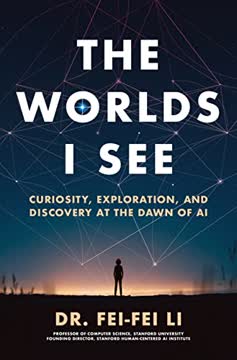Key Takeaways
1. The Rise of Facial Recognition: From Ancient Philosophy to Modern Technology
"Aristotle declared that man was the only creature on the planet with a true face."
Ancient roots. The concept of facial recognition has deep historical roots, dating back to Aristotle's belief that the face reflected a person's soul and character. This idea evolved through the centuries, with scientists like Francis Galton in the 19th century attempting to categorize people based on facial features.
Modern developments. The modern era of facial recognition began in the 1960s with Woody Bledsoe's work for the CIA, attempting to automate the process of matching faces. Progress was slow until the 1990s when Matthew Turk's "eigenfaces" approach at MIT marked a significant breakthrough. The technology gained momentum in the early 2000s, with events like the "Snooper Bowl" at the 2001 Super Bowl raising public awareness and concern.
2. Clearview AI: The Startup That Revolutionized Face Search
"It was a harebrained scheme to find out. A few members of the coalition invited Tyler to Comet Ping Pong—selected humorously, she said, because it was the unfortunate pizzeria at the center of the #PizzaGate conspiracy theory."
Controversial origins. Clearview AI emerged from the politically charged atmosphere of the 2016 U.S. presidential election. Founded by Hoan Ton-That, Richard Schwartz, and initially Charles Johnson, the company began as "Smartcheckr," aiming to create a tool for political vetting.
Technological leap. Clearview AI's breakthrough came from scraping billions of photos from social media and the internet, combined with advanced facial recognition algorithms. This allowed them to create a system that could identify almost anyone from a single photo, far surpassing previous technologies in scope and accuracy.
- Key features:
- Database of over 3 billion faces
- Ability to identify individuals from partial or low-quality images
- Integration with law enforcement agencies worldwide
3. The Ethical Dilemma: Privacy Concerns vs. Public Safety
"We can't let the need for COVID contact tracing be used as cover by companies like Clearview to build shadowy surveillance networks."
Privacy advocates' concerns. The widespread use of facial recognition technology has raised significant privacy concerns. Critics argue that it enables mass surveillance and erodes personal privacy, potentially leading to a society where anonymity in public spaces becomes impossible.
Law enforcement perspective. Proponents, particularly in law enforcement, argue that facial recognition is a powerful tool for solving crimes and enhancing public safety. They point to cases where the technology has helped identify criminals and missing persons.
- Ethical considerations:
- Consent: Most people in Clearview's database never agreed to be included
- Data security: Risks of breaches and misuse of personal information
- Chilling effect on free speech and assembly
4. The Technical Evolution: How AI Overcame Early Limitations
"Turk borrowed a technique from researchers at Brown University who had developed a method to digitally represent a face while minimizing the amount of computer memory it took up."
Early challenges. The initial attempts at automated facial recognition in the 1960s and 1970s were limited by computing power and the need for manual input. These systems struggled with variations in lighting, angle, and facial expressions.
Breakthrough technologies. The advent of neural networks and deep learning in the 2010s revolutionized facial recognition. Facebook's DeepFace and later advancements by companies like NEC and Clearview AI dramatically improved accuracy and scalability.
- Key technological advancements:
- Eigenfaces approach in the 1990s
- Deep learning and convolutional neural networks
- Vast increases in computing power and data availability
5. Government and Corporate Adoption: Surveillance Becomes Mainstream
"The facts we turn up cause friction," she said. "And our presence there means they're getting fewer matches."
Government deployment. Following the 9/11 attacks, there was a surge in government interest in facial recognition for security purposes. Airports, border controls, and law enforcement agencies began adopting the technology, often with little public oversight.
Corporate use. Private companies have also embraced facial recognition for various purposes, from unlocking smartphones to targeted advertising. Social media platforms like Facebook implemented automatic tagging features, further normalizing the technology.
- Examples of widespread adoption:
- China's extensive public surveillance system
- U.S. law enforcement agencies' use of Clearview AI
- Facial recognition payment systems in retail
6. Bias and Accuracy: The Ongoing Challenges of Facial Recognition
"The ACLU had been on the same side as Abrams in the Citizens United case."
Accuracy concerns. Despite significant improvements, facial recognition systems still face challenges in accuracy, particularly when dealing with diverse populations. Studies have shown that many systems perform less accurately on women and people of color.
Bias implications. The potential for bias in facial recognition systems raises serious concerns about fairness and discrimination, especially in law enforcement contexts. Cases of wrongful arrests based on misidentification have highlighted these issues.
- Factors contributing to bias:
- Underrepresentation in training data
- Algorithmic design choices
- Lighting and image quality differences
7. Global Perspectives: How Different Countries Approach Face Surveillance
"Every society needs to decide for itself what takes priority," she said, "whether it's security or human rights."
Varying approaches. Different countries have taken diverse approaches to facial recognition technology, reflecting their cultural, political, and legal contexts.
- China: Embraces widespread use for social control and public safety
- European Union: Stricter regulations prioritizing privacy rights
- United States: Fragmented approach with varying state and local laws
International implications. The global nature of technology companies and data flows creates challenges in regulating facial recognition across borders, leading to calls for international standards and agreements.
8. Legal Battles: The Fight to Regulate Facial Recognition Technology
"The judge said that the ACLU deserved its day in court against Clearview. Clearview's attempt to play the First Amendment card in its other lawsuits was similarly shot down."
Landmark cases. Legal challenges to facial recognition technology have been mounting, with Clearview AI at the center of many disputes. Key issues include privacy rights, consent, and the legality of scraping public data.
Legislative efforts. Some jurisdictions have passed laws regulating or banning facial recognition, while others are still debating appropriate measures. The Illinois Biometric Information Privacy Act (BIPA) has been particularly influential in shaping legal challenges.
- Notable legal actions:
- ACLU's lawsuit against Clearview AI
- EU regulators' fines and restrictions on Clearview
- San Francisco's ban on government use of facial recognition
9. The Future of Anonymity: Implications for Society and Individual Freedom
"Our faces may well be the final frontier of privacy."
Societal impact. The widespread adoption of facial recognition technology threatens to fundamentally change the nature of public spaces and social interactions. The ability to remain anonymous in public, long taken for granted, may become a thing of the past.
Potential consequences. The loss of anonymity could have far-reaching effects on personal freedom, political dissent, and social behavior. It may lead to self-censorship and alter how people engage in public life.
- Potential future scenarios:
- Ubiquitous facial recognition in public spaces
- Integration with augmented reality for instant identification
- New forms of digital identity management and privacy protection
Last updated:
FAQ
What's Your Face Belongs to Us about?
- Facial Recognition Focus: The book explores the rise of facial recognition technology, with a particular focus on Clearview AI, a startup known for its controversial facial recognition app.
- Privacy and Surveillance: It examines the implications of this technology on personal privacy, highlighting concerns about surveillance and potential abuses by individuals and governments.
- Historical and Real-World Context: The narrative provides a historical overview of facial recognition technology and includes real-life cases, such as wrongful arrests, to illustrate its societal impact.
Why should I read Your Face Belongs to Us?
- Timely and Relevant: As discussions around privacy and technology grow, this book offers critical insights into how facial recognition affects our lives today.
- In-Depth Research: Author Kashmir Hill combines investigative journalism with personal anecdotes, making complex technological concepts accessible and engaging.
- Ethical and Advocacy Focus: The book encourages readers to consider the ethical implications of technology and to advocate for better privacy protections.
What are the key takeaways of Your Face Belongs to Us?
- Surveillance State Reality: Facial recognition technology is becoming a tool for surveillance, potentially leading to a society where anonymity is impossible.
- Regulation and Awareness: There is a lack of comprehensive laws governing biometric data, leaving individuals vulnerable, and the book encourages public awareness of digital footprints.
- Ethical Considerations: The narrative raises important questions about the balance between security and privacy in a digital age.
What are the best quotes from Your Face Belongs to Us and what do they mean?
- “Privacy, a word that is notoriously hard to define…”: This quote highlights the evolving nature of privacy in the digital age.
- “The future is unevenly distributed”: It underscores the disparity in access to technology and its implications, suggesting that advancements benefit some while disadvantaging others.
- “You can’t ban technology”: This reflects the inevitability of technological progress and the challenges of regulating it, emphasizing the need for ethical considerations.
What is Clearview AI, as discussed in Your Face Belongs to Us?
- Facial Recognition Startup: Clearview AI is a company that developed a facial recognition app capable of identifying individuals from photos scraped from the internet.
- Law Enforcement Tool: The technology is marketed primarily to law enforcement agencies, raising ethical concerns about privacy and surveillance.
- Controversial Practices: The company operates in a secretive manner, often avoiding public scrutiny while facing backlash for its data collection methods.
How does Your Face Belongs to Us address the historical context of facial recognition technology?
- Early Development: The book traces the origins of facial recognition technology back to the 1960s, detailing initial challenges and failures.
- Technological Evolution: It highlights key milestones and advancements in the technology, including growing interest from law enforcement and private companies.
- Cultural Shifts: The narrative discusses changing societal attitudes towards privacy and surveillance, influencing the acceptance of facial recognition technology.
What are the ethical implications of facial recognition technology discussed in Your Face Belongs to Us?
- Potential for Abuse: The book raises concerns about misuse for harassment, stalking, and discrimination, especially against marginalized groups.
- Consent and Ownership: It emphasizes the lack of consent in using individuals' images in databases, questioning data ownership and rights.
- Surveillance and Control: The narrative warns of a future with constant surveillance, leading to a loss of personal freedoms and autonomy.
How does Your Face Belongs to Us illustrate the impact of technology on privacy?
- Real-World Examples: The author provides case studies and anecdotes demonstrating current uses of facial recognition in various contexts.
- Public Reaction: The book discusses mixed public responses to surveillance technologies, highlighting both fascination and fear.
- Call to Action: Hill encourages discussions about privacy rights and advocates for stronger regulations to protect against invasive technologies.
What challenges does Clearview AI face, according to Your Face Belongs to Us?
- Legal Scrutiny: The company is under threat of lawsuits and regulatory challenges due to its controversial data collection practices.
- Public Backlash: Clearview AI faces criticism from privacy advocates and civil rights organizations, impacting its reputation and operations.
- Competition and Innovation: As larger tech companies develop their own technologies, Clearview AI must innovate while navigating ethical concerns.
How does Your Face Belongs to Us address the balance between security and privacy?
- Security vs. Civil Liberties: The book explores the tension between security desires and the need to protect privacy rights, especially with surveillance technologies.
- Public Sentiment: It discusses how public opinion often favors security measures, sometimes at the expense of privacy, and the need for informed debate.
- Regulatory Advocacy: The author calls for a balanced approach prioritizing both security and privacy, emphasizing the importance of regulations.
What role do tech companies play in the proliferation of facial recognition technology, according to Your Face Belongs to Us?
- Market Demand: The demand for advanced surveillance tools has led tech companies to develop and market facial recognition technology.
- Corporate Responsibility: The book discusses the responsibility of tech companies to ensure ethical use and to advocate for privacy-protecting regulations.
- Potential for Abuse: Without proper oversight, facial recognition technology can be misused by private companies and governments, leading to surveillance and loss of liberties.
What future developments in facial recognition technology are suggested in Your Face Belongs to Us?
- Increased Integration: The book suggests facial recognition will become more integrated into everyday life, from security systems to social media.
- Regulatory Changes: It anticipates a push for stricter regulations as public awareness grows.
- Ethical Considerations: The narrative emphasizes ongoing discussions about ethical implications and the balance between innovation and privacy.
Review Summary
Your Face Belongs to Us is praised for its investigative journalism on facial recognition technology and Clearview AI. Readers find it informative, well-written, and eye-opening about privacy concerns. Many appreciate the historical context and ethical discussions. Some criticize political bias and wish for more technical details or solutions. The book is described as both fascinating and terrifying, leaving readers to contemplate the future of privacy and surveillance. Overall, it's highly recommended for its relevance and thought-provoking content.
Similar Books









Download PDF
Download EPUB
.epub digital book format is ideal for reading ebooks on phones, tablets, and e-readers.




